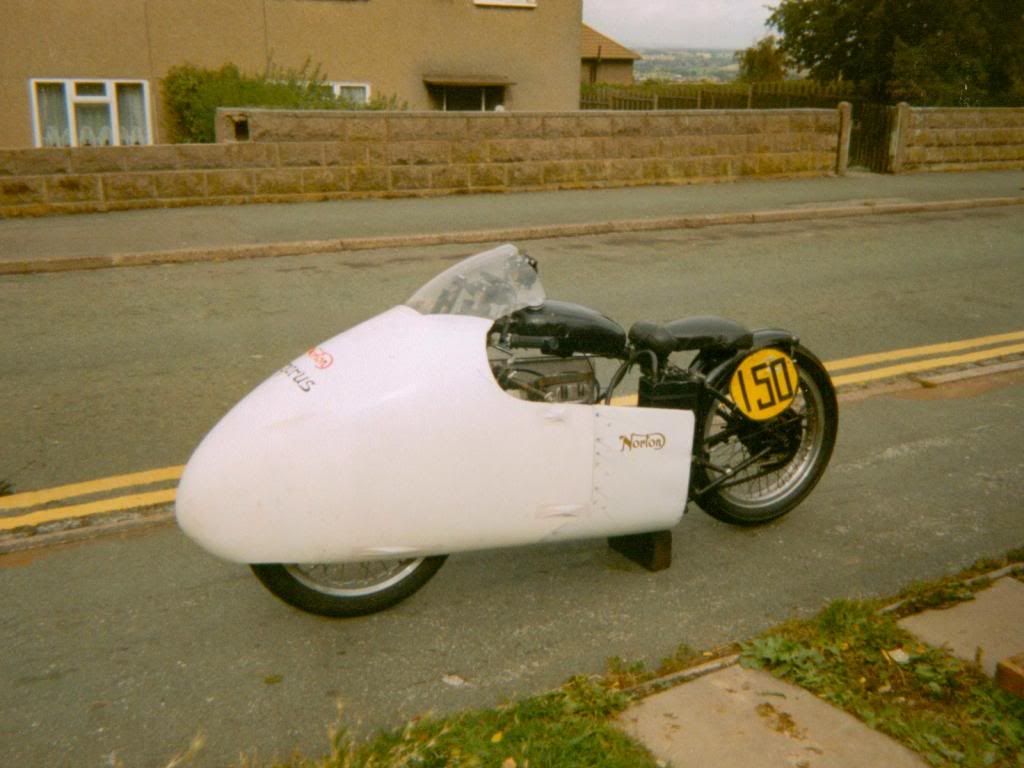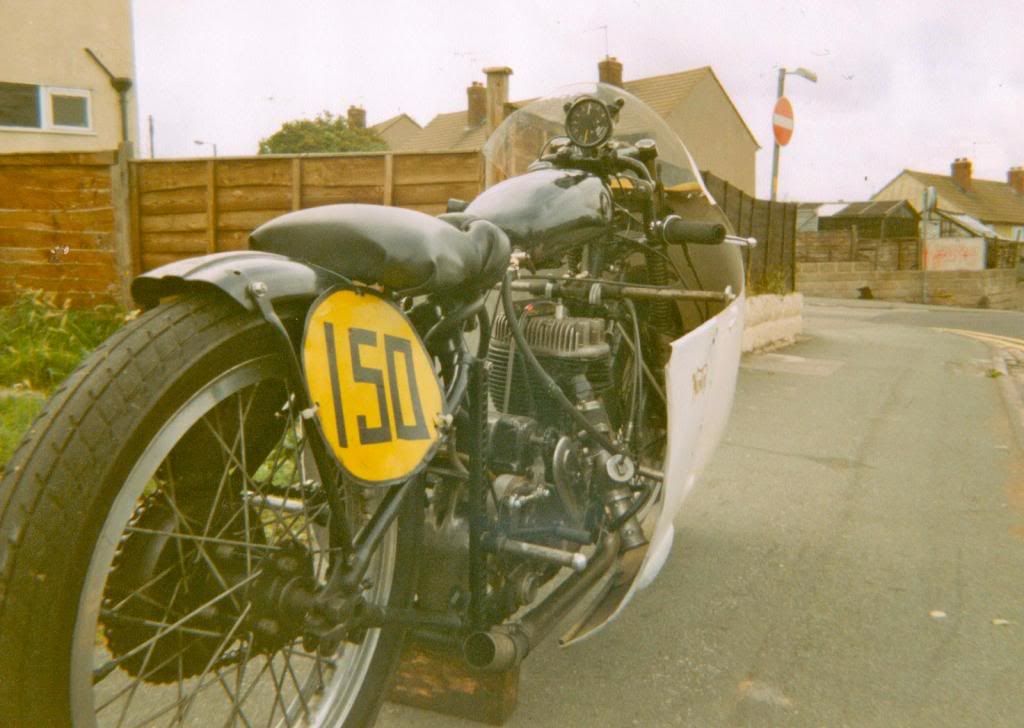Where did you find these pictures Keith..? Is there a website about it?
email (option): horror@blueyonder.co.uk
Horror
Try this address
http://www.vintagenorton.com/2011/03/121-mph-model-16h-racer.html
Hope this works it my first attempt at posting a link!
Have said this many times before, when wanting to add a clickable link, just type [ url ] before the link and [ /url ] behind it:
http://www.vintagenorton.com/search/label/Model%2016H%20Saddle%20Tank
Scroll down to article.
(without the spaces, but otherwise it doesn't show.) changed the link also, as it didn't work for me, John from the website is a friend, about a mile away from me, and can ask for more details if needed?
Cheers,
Lex
email (option): welbike@wish.net
This is Nigel Foxs' 16H..the current holder of the British single cylinder sidevalve record..It was actually recorded at 116mph and they calculated that it had theoretically hit 121mph during the run...The record stands at 116mph currently I believe. Pat Jeals M20 managed 112mph a few years back..but he wasn't trying for that record, merely to reach some personal targets...Ian
email (option): ian@wright52.plus.com
Stop pissing around on here Ian and get yours finished!! When you become famous, I'll be able to tell my mates....I know you!! Ron
email (option): ronpier@talk21.com
Ian, you mean he sh*t himself?? with all the bad handling on an M20 I would do too!!
Hope you seriously will better the record one day though,
Cheers,
Lex
email (option): welbike@wish.net
The speed attained was due to part to the "dustbin" fairing, which although effective in terms of reduced drag is now illegal in most venues as it makes the machine very susceptible to cross-wind upsets.
Adding 25% nitro to the fuel adds a great deal of power as well.
Jenkins used nitrous oxide.
Jeals only used 95% methanol and 5% acetone. More on this bike: http://victorylibrary.com/brit/enigmas3.htm
My take on the speed comment: a slight drop in terminal speed is frequently due to 1 of 2 things:
1. overall gearing was too tall (the motor was running too far below its power peak), or
2. 3rd gear was too far away from 4th, and the shift dropped RPM too much (same result).
This shows up occasionally as a comment "my bike is faster in 3rd than 4th!", which provokes rude and deprecatory remarks explaining "how that's impossible".
It happens - too much gear for the motor.
email (option): sales@victorylibrary.com
'Dustbins' are still allowed in UK sprinting...Mine is being made at the moment.
With the limited power potential of the sidevalve in normally aspirated form (the only way to have it to test your tuning capabilities) a fairing is really essential to obtain high speeds. At higher speeds, over about 60 mph, wind resistance has a far greater limiting effect than weight which becomes increasingly irrelevant....
Nitrous Oxide which is pressurised, supercharging or turbocharging all overcome the main problem (challenge) of tuning a sidevalve which is the poor breathing and inability to employ a high compression ratio...For that reason IMHO they rather defeat the object of trying to get the maximum power from a limited design by careful preparation and modification...The 'American' M20, even with NO2, has done 108mph and that figure probably reflects the lack of a fairing on that machine.
'Dope' fuel doesn't produce large power increases either because it is not possible to raise the compression sufficiently in a sidevalve to take advantage of its 'anti knock' properties..That would compromise the gas flow within the head and make it slower, not faster (as Harley Davidson found out with the K model racers.) Bikes running dope in an OHV format routinely run at 13 - 15 to 1 compression ratios.
The main advantage of dope fuels in the sidevalve application is the cool running effects...Note that the Norton has no air vents in the fairing...Ian
email (option): ian@wright52.plus.com
That's a really interesting article, it seem that everything you know about OHV tuning works in reverse on a SV. No more high octane fuel and high comp piston in the 16H from now on, parafin is the way to go 
Great stuff
email (option): horror@blueyonder.co.uk
With a sidevalve, as opposed to an OHV, raising the compression ratio directly and adversely affects gas flow and with poor gas flow you get poor cylinder filling.
If the cylinder hasn't got a lot of fuel/air mixture in it as a result it doesn't really matter how high the compression ratio is (within practical limits)...you won't get much power without much mixture to compress!!...That is the nub of the problem and the basis of the compromise that is inherent in tuning these engines...
In practice gas flow is the more important feature of the two, both in the ports and the cylinder head and has to be enhanced at the expense of compression ratio for best results...
Far less work has been done on the development of normally aspirated sidevalve engines than on OHV engines...Further development of the type was pretty much abandoned when the OHV layout became practical.
Harley Davidson took it as far as anyone in motorcycle engines and it is to them you have to look for the basics..along with the British Ariel tuner Hartley, who got good results in the 30's/40's...
However, the specifications for one engine cannot just be 'lifted' and applied to another and this is where the development of each individual engine becomes necessary....
There is an endless amount of information available on the principles of tuning OHV units but tuning sidevalves is a 'black art', with relatively little published information out there for guidance....but that is exactly what makes it interesting...It requires a higher level of thought and personal input...The fact you won't reach the speed of a Japanese 400 (or 250?) after all your efforts doesn't really matter..it's about relative gains from a low starting point..
 ....Ian
....Ian
email (option): ian@wright52.plus.com
True, data can't just be lifted (or scaled) between engines, even between models of the same brand.
There is a variable that's present in some cars and some bikes, in 2 general types:
1. valve stem is parallel to the bore in both axes (M20, Chief, Scout)
2a. valve stem is inclined toward the bore in the lateral (left to right) axis such as Ford V8, Hudson L6
2b. valve stem is inclined to the bore in the radial (front to rear) axis such as (almost) all 1929-73 H-D sidevalves including 45, 74 & 80
2c. valve stem is inclined to the bore in both 2a. and 2b. axes such as 1940 WLDR "special", 1941-52 WR, 1952-69 K/KR/KH
Type 1. are generally adaptable between brands, with scaling dependent on other factors such as bore-to-stroke ratio and chamber dimensions. Type 1. chamber floor can be perfectly flat, and the roof nearly so.
Type 2a. - 2c. have a 3-dimensional chamber volume with the seats angled away from the gaslet surface, and don't adapt well to other types. The K chamber has been transposed to 45 cylinders with indifferent results.
2a. valve seats are the initial points of relieving; 2b./c. are counter-intuitive.
2a. - 2c. chamber floors are never flat, nor the roof.
Motors with low bore-to-stroke ratios have higher maximum static CR values. Chief 80 is very different at 3.25" ÷ 4.8125" = 67.5% than the Scout at 2.875 ÷ 3.50" = 82.1%.
KH is the largest common at 2.745 ÷ 4.5625 = 60.2%, compare to the 45 or K at 2.745 ÷ 3.8125 = 72%.
email (option): sales@victorylibrary.com
Apart from a capacity change the bore to stroke ratio on my sprinter is altered as well....Standard M20 is 'undersquare' at 87%...The sprinter falls into the 'square' category at 96%....Ian
email (option): ian@wright52.plus.com



